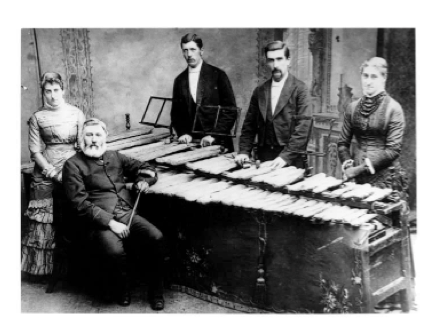JUNE 11, 1785: ROCK MUSIC INVENTED
In the Lake District village of Keswick—helpfully described by one contemporary traveler as a “filthy town”—retired sailor Peter Crosthwaite notices that rocks along the River Greta produce a surprisingly musical tone when struck. These rocks are a unique local variety of hornblende slate and gneiss, and Crosthwaite eventually assembles a tuned set of sixteen musical stones. For decades afterwards, Crosthwaite’s Museum in Keswick is home to the first rock instrument.
1837: FIRST ROCK BAND
Joseph Richardson, a mason in Keswick, also notices as he works that some of the stones he hammers produce pleasantly ringing tones. He spends thirteen years collecting rocks off the local mountain of Skiddaw, laboriously hauling them home and hammering them in the dead of night. Despite supporting eight children, by 1837 he has painstakingly built a “rock harmonicon,” a massive two-tiered stone xylophone covering five and half octaves. Utilizing sixty-five pieces of rock and played with wooden mallets, the Rock Harmonicon requires three players. The world’s first rock band—the Richardson Rock Band—is born.
1842: FIRST ROCK CONCERT
The Richardson Rock Band explodes onto the London scene with a rough-hewn set of waltzes and quadrilles. MUSIC FROM ROCKS, proclaim ads in the Times, and the Illustrated London News hails the shows, noting that “difficult chromatic ascents and descents are performed with truly extraordinary brilliancy and crispness.” But fame and fortune soon creates rivals: fellow Keswick stonemason William Bowe debuts his own sixty-rock instrument in Edinburgh, while the Harrison Rock Band stages daily rock concerts at the Royal Surrey Zoological Gardens.
1845: FIRST ROCK STAR DEATH
Spurred by these upstarts, the Richardson Rock Band rocks even harder, advertising themselves as the “Original Rock Band” and announcing a “Monster Stone Concert.” The band triumphantly plays to packed houses at Egyptian Hall in London. But the rock life proves too much in the end, and in 1845 band founder Joseph Richardson is found dead in his home at 134 Edgware Road. His depleted Rock Band soldiers on without him for a couple more years before disappearing.
1892: FIRST BRITISH INVASION
Rock music languishes until promoter William Till stages its comeback in 1881 at the Royal Polytechnic in London. The art critic John Ruskin writes admiringly to the Till Family Rock Band: “You may have given me, with a new insight into the nature of crystalline rock substance, also a musical pleasure.” After conquering the U.K., the Tills cross the Atlantic and rock American kindergartens and Sunday schools, becoming the first band to bridge the gap between youth culture and highbrow art critics. The Tills settle in New Jersey, establishing Bayonne as the world capital of rock music.
1957: FIRST CONCEPTUAL ROCK BAND
John Lennon and Pete Shotton form the Quarry Men in Liverpool. The band does not include any actual rocks in their instrumentation.
1972: FIRST ROCK MOVIE
Rock music makes its big-screen debut in What’s Up, Doc?, starring Barbara Streisand, Ryan O’Neal, and Madeline Kahn. O’Neal plays Dr. Howard Bannister, a musicologist whose bag of resonant igneous rocks gets switched with identical luggage en route to San Francisco. A sample of the dialogue: “It so happens, Mr. Simon, that Howard had discussions with Mr. Bernstein about the possibility of conducting an avalanche in E flat.”
2000: FIRST ROCK ROAD SHOW
Engineers in the Paris suburb of Villepinte make clever use of road noise between tires and crushed rock asphalt by designing a corrugated “euphonic road” surface that gives a twenty-eight-note melody when driven over. Complaints by neighbors result in the road being resurfaced in 2002. A subsequent visit establishes that one can still faintly hear the melody when the road is driven over.
THE PRESENT:
POSTMODERN ROCK
The Vienna Symphonic Library releases a digital sampler disc recreating the entire range of a five-octave rock harmonicon. Composers are freed from the trouble of having to find their own rocks, bringing about the final culmination of an artistic paradox: rock music that does not, in fact, contain any rock at all.





